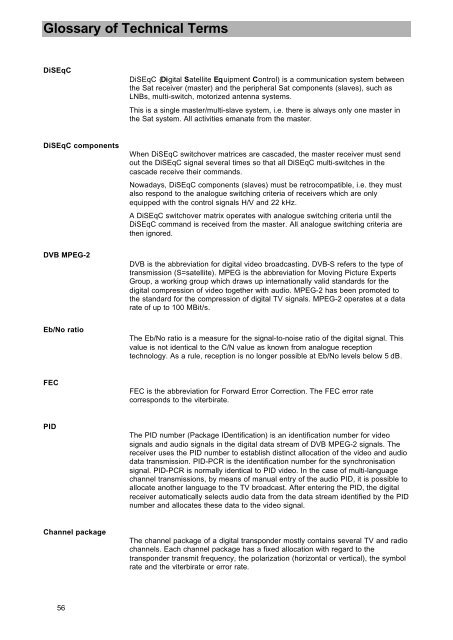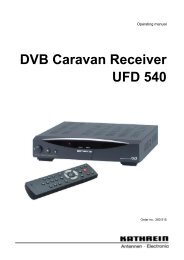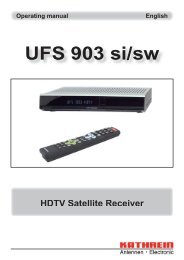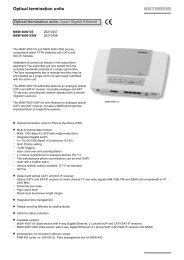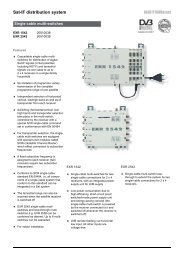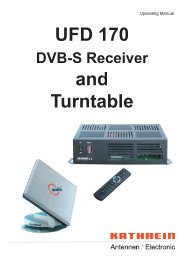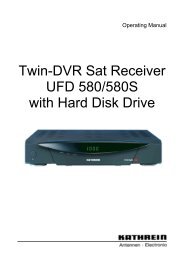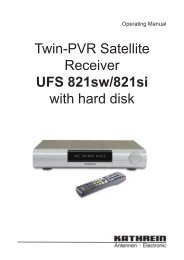9986252-DVB Satellite Receiver UFD 545 - Kathrein
9986252-DVB Satellite Receiver UFD 545 - Kathrein
9986252-DVB Satellite Receiver UFD 545 - Kathrein
You also want an ePaper? Increase the reach of your titles
YUMPU automatically turns print PDFs into web optimized ePapers that Google loves.
Glossary of Technical Terms<br />
DiSEqC<br />
DiSEqC components<br />
<strong>DVB</strong> MPEG-2<br />
Eb/No ratio<br />
FEC<br />
PID<br />
Channel package<br />
56<br />
DiSEqC (Digital <strong>Satellite</strong> Equipment Control) is a communication system between<br />
the Sat receiver (master) and the peripheral Sat components (slaves), such as<br />
LNBs, multi-switch, motorized antenna systems.<br />
This is a single master/multi-slave system, i.e. there is always only one master in<br />
the Sat system. All activities emanate from the master.<br />
When DiSEqC switchover matrices are cascaded, the master receiver must send<br />
out the DiSEqC signal several times so that all DiSEqC multi-switches in the<br />
cascade receive their commands.<br />
Nowadays, DiSEqC components (slaves) must be retrocompatible, i.e. they must<br />
also respond to the analogue switching criteria of receivers which are only<br />
equipped with the control signals H/V and 22 kHz.<br />
A DiSEqC switchover matrix operates with analogue switching criteria until the<br />
DiSEqC command is received from the master. All analogue switching criteria are<br />
then ignored.<br />
<strong>DVB</strong> is the abbreviation for digital video broadcasting. <strong>DVB</strong>-S refers to the type of<br />
transmission (S=satellite). MPEG is the abbreviation for Moving Picture Experts<br />
Group, a working group which draws up internationally valid standards for the<br />
digital compression of video together with audio. MPEG-2 has been promoted to<br />
the standard for the compression of digital TV signals. MPEG-2 operates at a data<br />
rate of up to 100 MBit/s.<br />
The Eb/No ratio is a measure for the signal-to-noise ratio of the digital signal. This<br />
value is not identical to the C/N value as known from analogue reception<br />
technology. As a rule, reception is no longer possible at Eb/No levels below 5 dB.<br />
FEC is the abbreviation for Forward Error Correction. The FEC error rate<br />
corresponds to the viterbirate.<br />
The PID number (Package IDentification) is an identification number for video<br />
signals and audio signals in the digital data stream of <strong>DVB</strong> MPEG-2 signals. The<br />
receiver uses the PID number to establish distinct allocation of the video and audio<br />
data transmission. PID-PCR is the identification number for the synchronisation<br />
signal. PID-PCR is normally identical to PID video. In the case of multi-language<br />
channel transmissions, by means of manual entry of the audio PID, it is possible to<br />
allocate another language to the TV broadcast. After entering the PID, the digital<br />
receiver automatically selects audio data from the data stream identified by the PID<br />
number and allocates these data to the video signal.<br />
The channel package of a digital transponder mostly contains several TV and radio<br />
channels. Each channel package has a fixed allocation with regard to the<br />
transponder transmit frequency, the polarization (horizontal or vertical), the symbol<br />
rate and the viterbirate or error rate.


